Tired of the mysterious supply chains and hidden environmental cost of modern design?
Well, here’s an antidote: The No Waste Chair. It doesn’t just hold you – it lets you peek right inside. Instead of foam and springs, you’ll find meticulously organized trash that tells a clear, unsettling story of our wasteful ways. Artless, yet undeniably art.
To learn more, we interviewed its Dutch designer and maker, Kees Dekkers. So, without further ado, kick back and relax on your classic, non-transparent chair – and let’s learn more about the No Waste one.
Let’s kick things off with an intro. What inspired the creation of No Waste Chair, and how did your background influence the concept?
There are many points of reference from which the No Waste Chair originated; a convergence of thoughts and events gave me the idea for the No Waste Chair. At that time (late 2019), I saw many commercials about trading in products with wheels for a discount on a new car. I thought to myself, what do they do with them? Where do all those products go and how much of them do they recycle? They probably don’t recycle anything, I thought to myself… Another inspiration came during one of my internships that I had to do for my studies in Design Furniture Making. I saw all the wood shavings we got from working with wood disappear into the bulky waste, a terrible waste, pure wood without any contamination, straight into the incinerator. Then I thought, why not make a piece of furniture that I can fill with all these types of waste, so they don’t have to be incinerated, and it doesn’t matter if they are contaminated or consist of different types of materials. That’s how the idea for a transparent and fillable product came about. It had to be a chair, because the chair symbolizes the time in which we live. And so the No Waste Chair was born.
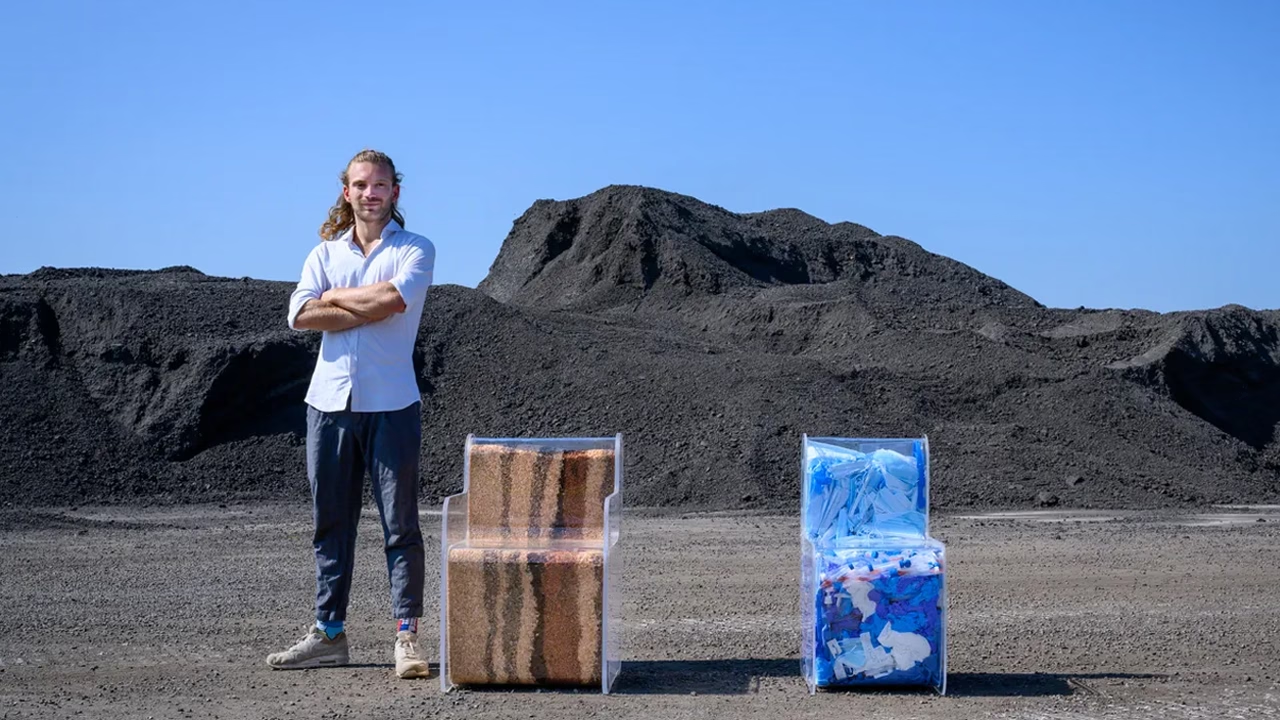
The chairs feature quite a range of waste, from footballs to cans of Coke. What’s the process of selecting and working with different waste materials for each chair?
In everyday life, I encounter various types of waste, on the street, at festivals, or on the news. This inspires me to create a new chair. I then call or email to get the waste. I also work with companies and organizations, who ask me if I can make a chair out of their waste. First, we discuss the content and the story. We look at what they have. The waste cannot be too large (15 cm maximum) or wet (unless it can dry), those are the only requirements. Once I have it, I sort it by color or size to know exactly what I have, and I visualize what it should look like. Then I take at least a day to assemble and make the chair.
Which No Waste Chair project has had the most surprising or emotional impact – and why?
The cigarette chair par excellence. Everyone who walks past the chair with approximately 50,000 cigarettes in it stops, looks, takes a photo (and sends it to their parents/children/friends). It really makes a big impact.
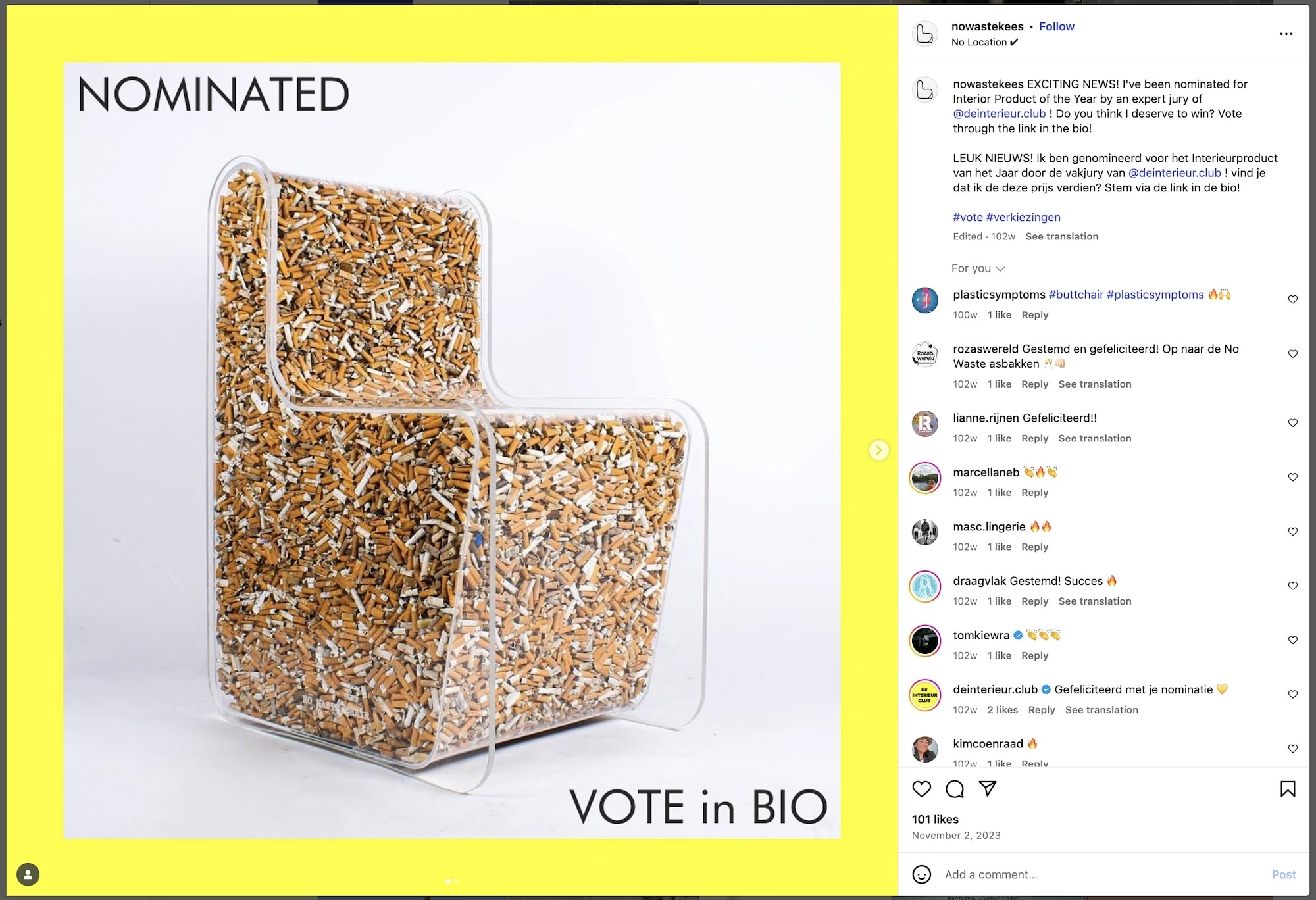
How do you typically collaborate with brands to turn their specific waste streams into a unique design – and do you have a favourite collaboration?
First, we have an exploratory conversation about what they want to include or what story they want to convey. They serve different purposes, such as raising awareness, activating, or inspiring. To do this, it is important that you gather the right materials and provide the right output on social media. I found the collaboration with Colmar and Natuurmonumenten to be the most special; they were very authentic and genuine.
What are some of the biggest design or technical challenges you’ve encountered when working with unusual waste materials?
Because the chair is universal, I don’t have any technical challenges; any material can be used in it. The cigarette butt chair was tricky, though; the cigarettes had to be really dry, which took a while. The floor was completely littered with cigarette butts, and I had to turn it every other day so that other cigarette butts would be on top.
What do you hope people take away when they see or sit in a No Waste Chair? Beyond aesthetics, what kind of behavior or mindset shift are you hoping to spark?
What I like to see is when you can read on people’s faces that they are shocked or surprised. We always explain what and how much it is and bring it down to a human level, so 50,000 cigarettes is a pack a day for seven years. One cigarette pollutes more than 500 liters of water, and in the Netherlands, around 350 of these chairs are thrown on the ground every day, which makes them stop and think. Hopefully, next time they will throw their cigarette butt in the trash.
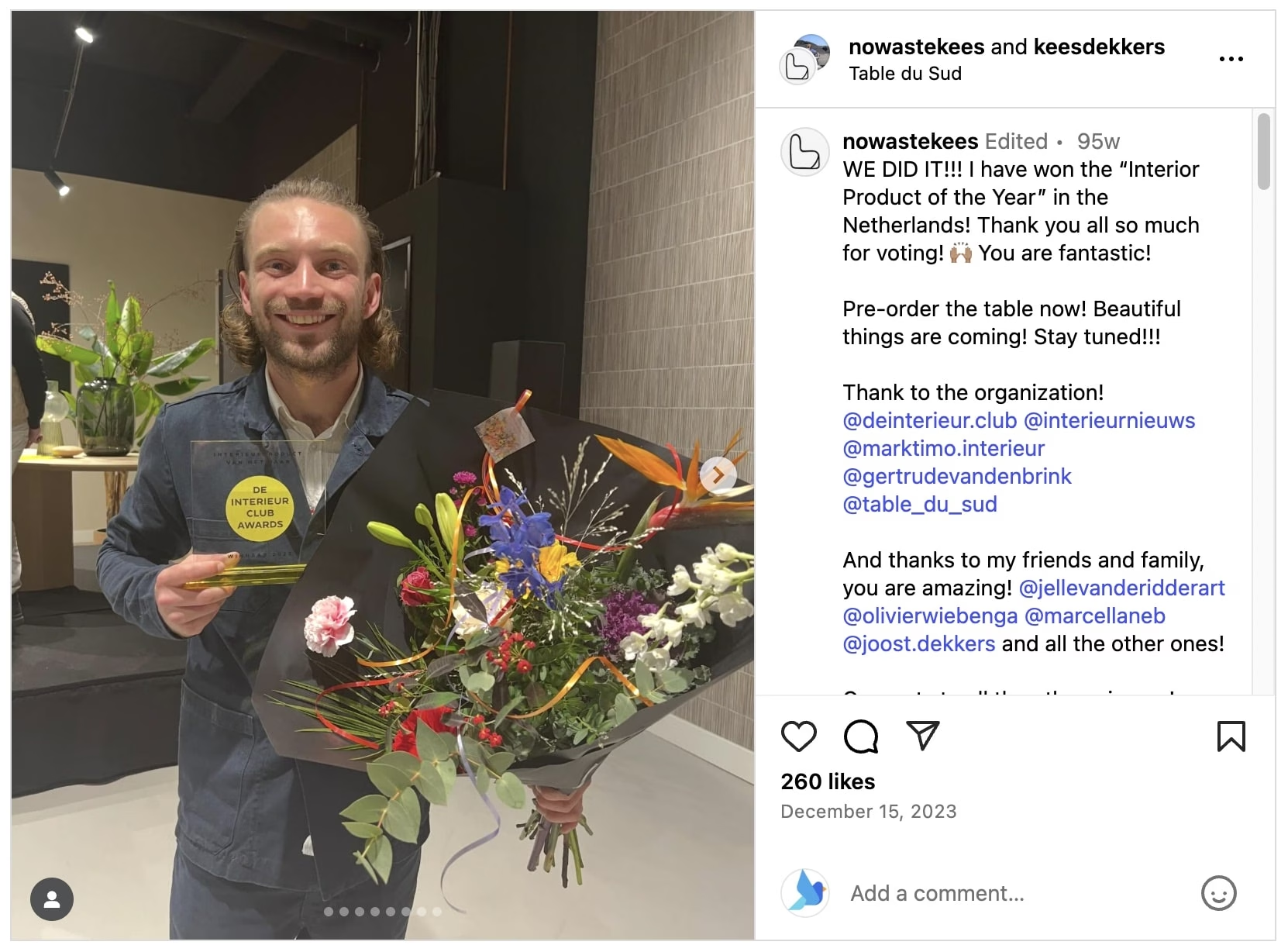
Are the chairs themselves fully circular – can they be refilled, reused, or recycled at the end of their life?
The chairs can be refilled, the material itself is made from 100% recycled plastic and can also be 100% recycled.
You’ve recently expanded into tables and larger installations. What guides those creative decisions?
That’s up to me (Kees Dekkers). Lately, we’ve been more focused on serving our customers than expanding, but we’re also introducing a consumer chair that’s very easy to fill yourself and comes in a variety of colors.
Can individuals or smaller organizations commission a custom No Waste Chair? What does that process look like?
Individuals can order the chair and fill it themselves from the back (the new model). Custom-made chairs are discussed with me, and then we look at what they want to put in it. They send the items to me, and I deliver the chair later.
Sustainability can be a tricky concept to pin down but we always ask our interviewees to make an attempt. How would you define ‘sustainability’?
Sustainability is a meaningless term these days. It’s used everywhere, and anyone can use it without anyone checking what it actually means. I see it as raw material costs and weighing up the process against use and quality. I always use gasoline as an example; if we could drive 1,000 kilometers on 1 liter of gasoline, it would be quite sustainable. If something polluting lasts a long time and is used a lot, it might be worthwhile if the much cleaner solution is not feasible at all, which is also not sustainable. I buy a lot of second-hand items myself, and only quality ones.
Touché! Could you tell us about some of the most exciting sustainable projects that you admire for taking a more circular / zero waste approach?
I think deposits on furniture are a very good idea, or phones where you can easily replace parts yourself. I once came up with the idea of putting a deposit on cigarettes, so that the less fortunate could collect them and benefit from them, as the streets are littered with them!
What’s next for No Waste Chair? Are you exploring new materials, collaborations, or formats you can give us a sneak preview of?
We would like to take on larger projects such as conference tables, which have a significant impact during meetings. We are also open to larger installations that are not related to interior design.
Over to you in your basic chair. Would you like to know more about this No Waste chair? Would you like to invest in a chair to put some detritus in? Or maybe you’d like to sit on one, or peer inside one? Or or are you just interested to learn more about where Kees’ story’s going? Then find out more on No Waste Chair’s website or Instagram.
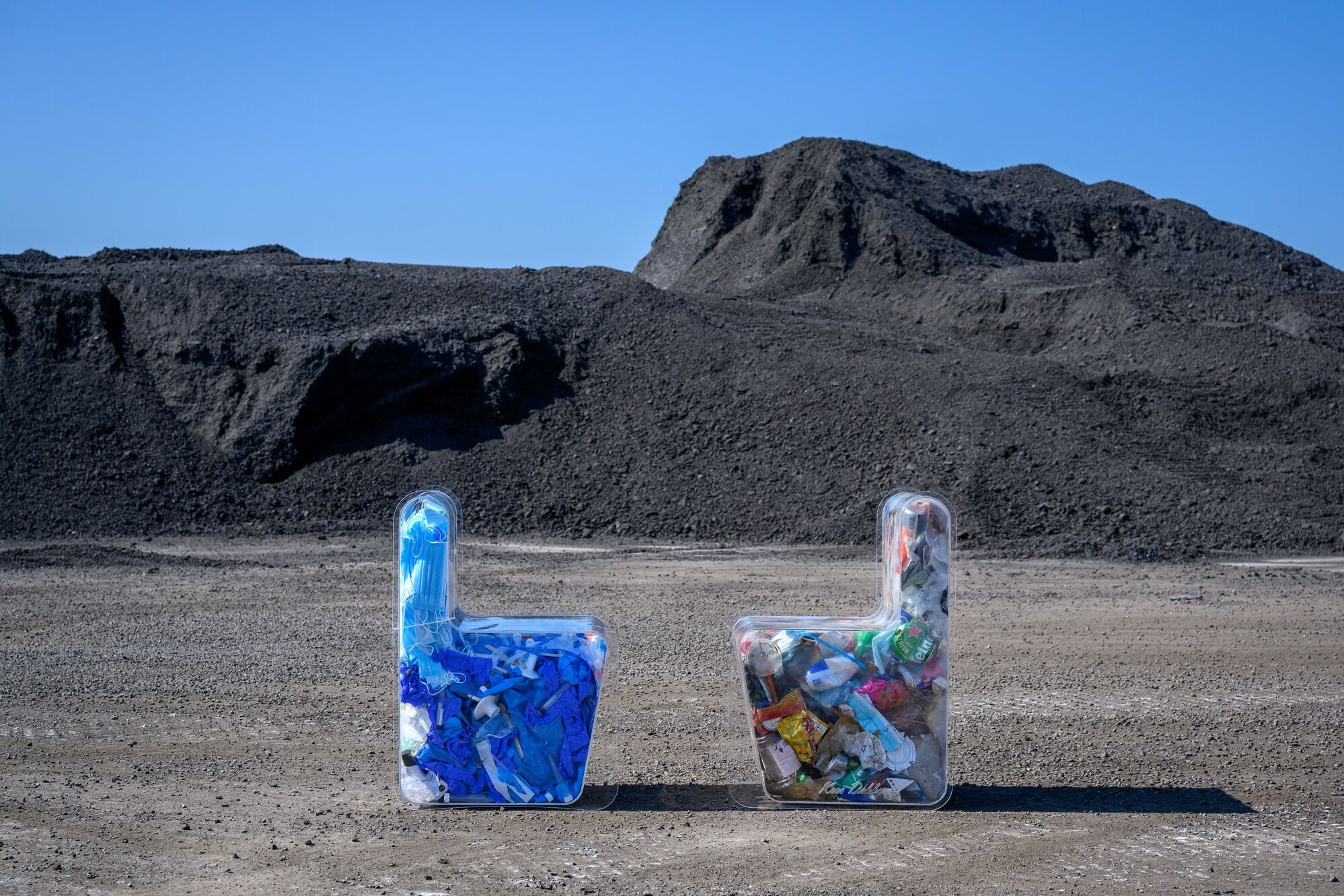
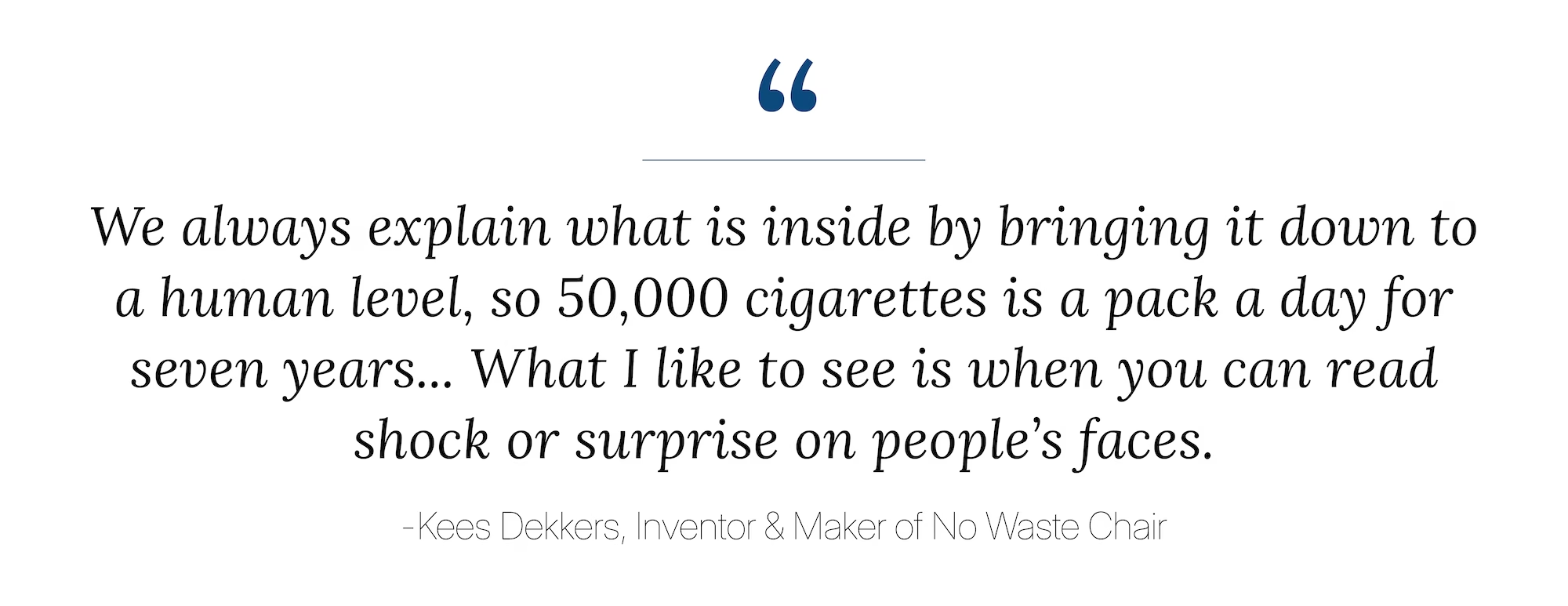


Leave a Reply